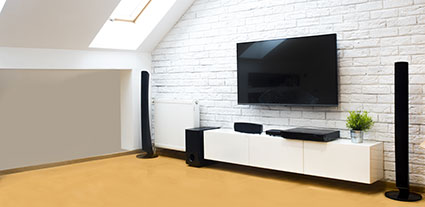Whether you enjoy snuggling up and binge-watching a tv series or you’re a fan of home movie nights, a home theatre can be a fantastic addition to any house. You don’t need to go full ’00s MTV Cribs to enjoy the movies from home either. For many families, home theatres have been an excellent alternative to popcorn-littered rooms and cold air conditioning in the average cinema. When it comes to home theatre installation, we cover all you need to know to transform an underused room or your current living space into a real-life home theatre to enjoy whenever you feel like it. Read on to find out more:
Is my home suitable for a home theatre?
While old-school home entertainment systems are bulky, unwieldy, and prohibitively costly, home theatre technology is more affordable than ever. As such, it’s accessible for thousands of homes across Australia, and infinitely adaptable to work in your specific space, provided you’ve got a few of the basics covered. The first thing to consider when you invest in a home theatre installation is whether you have the room for it. Your smaller television may work well in your current movie-watching space, but a cinema-size screen or even a projector needs a certain amount of space to be practical or useable. No-one likes sitting in the front row at their local cinema and craning their neck; you won’t want that at home. If the room you plan to use is rectangular, you could always shuffle around the position of your furniture for that extra bit of space.
Choosing your setup
Once you’ve decided if your home is suitable for a home theatre, the next exciting step is deciding exactly what you want for your home cinema experience. There are hundreds of different options, combinations, and brands to pick from when it comes to getting your setup right for you. In some homes, built-in ceiling speakers and a large mounted TV is the right fit. In others, a projector is the best fit. It all depends on your personal preference, what you’d like the room to look like, and of course, your own budget limitations.
Projector or TV?
The first thing you’ll want to consider when it comes to the specific tech you use in your home theatre is whether you want a projector or TV. Each has particular benefits. TVs can be installed quickly, have excellent backlighting and often include speakers. They are also versatile for multiple mediums, such as playing games or watching content online directly through a Smart TV service. By contrast, projectors are a more versatile solution for movie-watching. If you want to adjust the screen to any size, and you want that classic cinema experience, a projector is a great fit. Not to mention a quality projector is far less costly than an expensive TV, and much more portable too. Up for a movie night on a warm summer’s night? All you need to do is move the projector, hang a sheet, and you’ve got movie magic wherever you want in your home.
Built-in or external surround sound?
Great audio is a must for that cinema experience, and much like with your visual display, there are several options to suit your needs. For some, a simple soundbar setup is more than enough. For others, having surround sound dotted around the room can provide that 4D experience when they’re watching the latest blockbuster or binging a vintage TV show. If you’re concerned about tripping over wires or you don’t like the idea of speakers concealed throughout your cinema room, the other option is inbuilt speakers. Built into the walls, ceilings and even into furniture in some instances, these speakers are streamlined and effective. The only downside is that the costs for repair and replacement are going to be far higher; installation will require some up-front demolition for this audio-perfect finish.
Sleek and simple or the whole cinema experience?
A large part of choosing the home theatre you want is the interior design of your home. After all, if you’re all about the sleek and streamlined feel, you don’t want wires trailing everywhere. Similarly, if you want a multifunctional space, you’ll have different requirements than you would have for a dedicated home theatre room. Understanding what you want your final setup to look like is key to ending up with something you’ll love long-term. That might be a hidden projector screen or practical large-scale television that can be hooked up to consoles and used day-to-day or something ultramodern and stylish. Working to find something that suits your interior design preferences will ensure you have a result that is both functional and visibly appealing. Depending on the level of work required, a home theatre can be a long-term and permanent investment, after all.
Do I need an electrician to install a home theatre?
You may think electricians as limited to rewiring houses or connecting up lights, but when it comes to your home theatre system, a skilled sparkie is exactly what you’ll need. Depending on your setup choice, a lot of wiring will be involved to turn your dream into a reality – and working with an expert is the best way to get the job done to a high standard. From installing wall and ceiling speakers to hanging and hooking up your brand-new cinema-scale TV, an electrician can provide valuable insight into what will and won’t work for your specific home.
How do I get started on my home theatre installation?
That’s up to you! For some people, working with a service that does it all, from install to sourcing electronics, is the ideal choice. But if you’re on a budget or you have something specific in mind, you can always source all the parts separately. Always make sure your sound system and TV or projector are compatible. Still, beyond that, a qualified electrician would be able to complete the home theatre install quickly and easily for you, with excellent results. If you’re thinking about a home theatre, the best thing you can do is have a plan in place. Then leave all the hard work to a professional service like Smillie Electrical and enjoy the results. Popcorn, anyone?



